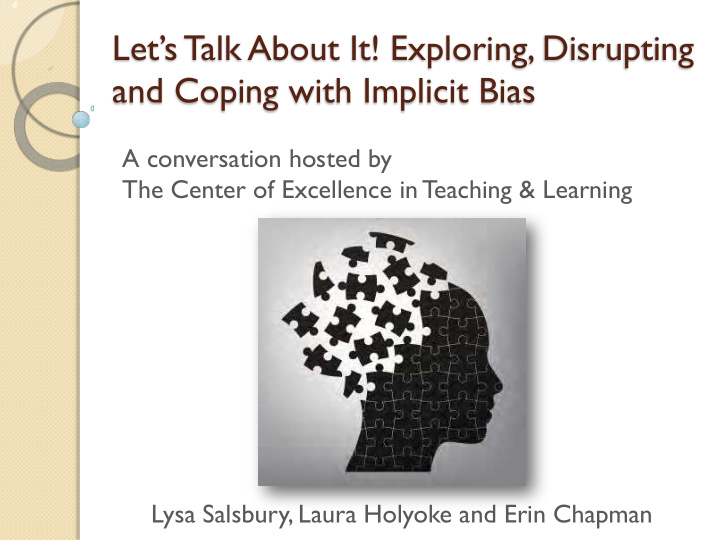



Let’s Talk About It! Exploring, Disrupting and Coping with Implicit Bias A conversation hosted by The Center of Excellence in Teaching & Learning Lysa Salsbury, Laura Holyoke and Erin Chapman
Implicit Bias
Stereotypes • Reduced or simplified characteristics attributed to a group of people • Assist in categorization and meaning making • Can be positive or negative • Unearned
Man Box / Woman Box Man Box When someone says, “Act like a man,” what are the expectations implied by this? How are men expected to behave? What happens if they don’t? Woman Box What are the expectations of “acting like a lady - or a woman?” How are women expected to behave? What happens if they don’t?
Tell us about these people… Qualities of a Leader
Pair-share Discussion: In what ways does implicit bias hurt women and underrepresented individuals in academia?
Microaggressions The everyday verbal, nonverbal, and environmental slights, snubs, or insults, whether intentional or unintentional, which communicate hostile, derogatory, or negative messages to target persons based solely upon their marginalized group membership.
Microaggressions “Death by a thousand cuts.” Microaggressions are active manifestations and/or reflections of our worldviews of inclusion/exclusion, superiority/inferiority, normality/abnormality, and desirability/undesirability.
How do we address our own bias? Recognize that, as human beings, our brains make assumptions without us even knowing it. Micro-affirmations Open doors to opportunity - power sharing vs. power hoarding Gestures of inclusion Intentional acts of listening
Interrupting Oppressive Behavior: An Action Continuum What happens when you encounter Microaggressions? Do you have a plan for what you might do or say? Whenever you experience oppressive behavior, you can choose your reaction from a range of possible responses:
What You Can Do As a supervisor or colleague: ◦ Implicit bias is REAL. Believe people and listen when they say they’re experiencing it. ◦ Be mindful of your first impressions of others. If they are negative, ask yourself why. ◦ Encourage and foster equal participation and opportunity. ◦ Recognize the power of images and symbols. ◦ When you recognize your own or others’ bias, name it. Take action. ◦ Other suggestions?
What You Can Do As someone experiencing implicit bias: ◦ Set firm boundaries and be consistent from the beginning ◦ Class/workplace experiential activities ◦ Group readings/trainings ◦ Talk with your supervisor and establish their support ◦ Seek out allies ◦ Keep records of the behavior ◦ In the moment…. ◦ T echniques that have worked for you?
What You Can Do Increase your personal and psychic strength by: ◦ Reminding yourself about your value ◦ Practicing self-care (self-preservation) ◦ Thinking about the “bigger fish you have to fry” by putting this interaction into the broader context of your life goals ◦ Practice gratitude Increase your social resources by: ◦ Participating in mentoring programs ◦ Building your network of mentors (multiple)
Mindful Awareness Practice JUST LIKE ME
Wrap-up How can YOU start to make a difference?
Recommend
More recommend